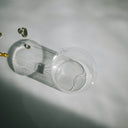Hair loss can be a distressing experience for many individuals, leading to the search for effective treatments. One of the most discussed solutions is minoxidil, a topical treatment commonly used to combat hair thinning and promote hair regrowth. But does minoxidil actually thicken hair? In this article, we will explore the science behind minoxidil, how it works, and its effectiveness in thickening hair, providing you with a comprehensive understanding of this popular treatment.
Table of content
Does minoxidil thicken hair?
Yes, minoxidil can help thicken hair, but its effectiveness varies among individuals. Minoxidil works by stimulating hair follicles, increasing blood flow to the scalp, and prolonging the growth phase of hair. This treatment has been shown to promote hair regrowth in those experiencing androgenetic alopecia (male or female pattern baldness) and can result in thicker, fuller hair over time. However, the degree of thickening and regrowth can depend on factors such as individual response to the medication, the duration of use, and the severity of hair loss.
Minoxidil is FDA-approved for use in both men and women and is available in both liquid and foam formulations. When applied as directed, it can activate dormant hair follicles and encourage new hair growth. Many users report noticeable improvements in hair thickness and density after consistent use for at least 4 to 6 months, although full results may take up to a year.
To maximize the potential benefits of minoxidil, it is essential to apply it to a clean, dry scalp and to follow the recommended dosage. Users should also be aware that while minoxidil can facilitate hair thickening, it is not a permanent solution. Continuous use is required to maintain results, and discontinuing treatment may result in hair loss reverting to its previous state.
As your leading source for hair health information over the past 4 years, we never compromise on accuracy. When it comes to your health, you deserve information you can truly rely on - and earning your trust is our top priority.
Here's how Scandinavian Biolabs ensures every piece of content meets the highest standards of accuracy and integrity:
- Credentialed Experts: Our reviewers are actively practicing doctors and medical researchers
- Stringent Reviews: Content undergoes rigorous editing by subject specialists and review by a practicing doctor.
- Evidence-Based: We rely on well-established research from trusted scientific sources like peer-reviewed journals and health authorities.
- Full Transparency: Our editorial standards, writer credentials, reviewer credentials, correction process, and funding are all publicly documented.
- Independent Voice: While we do promote products, we operate in a vacuum to business operations. Our main goal is just an unwavering commitment to providing medically-sound guidance.
You can count on Scandinavian Biolabs to consistently deliver the trustworthy health information you deserve. Read our Editorial Standards.
Understanding how minoxidil works
Minoxidil was originally developed as an oral medication to treat high blood pressure. Researchers discovered that one of its side effects was hair regrowth, leading to its formulation as a topical solution. The exact mechanism by which minoxidil promotes hair growth is not entirely understood, but several theories exist.
One primary action of minoxidil is its ability to widen blood vessels in the scalp. By improving blood circulation, it enhances the delivery of essential nutrients and oxygen to hair follicles, promoting healthier hair growth. Additionally, minoxidil may stimulate the production of certain growth factors that encourage the proliferation of hair follicle cells, leading to thicker hair strands.
What to expect when using minoxidil
When starting minoxidil, it is important to set realistic expectations. Initial hair shedding is common during the first few weeks of treatment, as old hairs fall out to make way for new growth. This can be disheartening, but it is a normal part of the process. Over time, most users begin to notice new hair growth, often starting with fine, soft hairs that may gradually thicken.
Results can vary significantly from person to person. Some individuals may see noticeable improvement within a few months, while others may take longer to respond. The extent of hair thickening also depends on the individual's hair loss pattern and the duration of their condition. For best results, it is recommended to use minoxidil consistently and as directed, typically twice daily for the most effective outcomes.
Potential side effects of minoxidil
While minoxidil is generally considered safe for most users, it can cause side effects in some individuals. Common side effects may include scalp irritation, dryness, and itching at the application site. In rare cases, users may experience more severe reactions, such as rapid heart rate, dizziness, or swelling of the face and hands. If any serious side effects occur, it is crucial to discontinue use and consult a healthcare professional.
Users should also be cautious when applying minoxidil, as it can cause unwanted facial hair growth if it comes into contact with areas other than the scalp. Proper application techniques can help mitigate this risk.
Alternatives to minoxidil for hair thickening
For those who may not respond well to minoxidil or prefer alternative treatments, several options are available. These include:
- Finasteride: An oral medication for men that blocks the hormone responsible for hair loss.
- Low-Level Laser Therapy (LLLT): A non-invasive treatment that uses laser light to stimulate hair follicles.
- Hair transplant surgery: A surgical option for individuals seeking more permanent results.
- Natural remedies: Some users explore essential oils, vitamins, and dietary changes to promote hair health.
Conclusion
In summary, minoxidil can effectively thicken hair for many individuals dealing with hair loss. By stimulating hair follicles and improving blood flow to the scalp, it helps promote hair regrowth and increases hair density. However, results can vary, and it is essential to maintain realistic expectations and adhere to the recommended usage guidelines. If you are considering minoxidil as a treatment option, consulting with a healthcare professional can help you determine the best approach for your specific hair loss concerns.
Minoxidil Side Effects Got You Down? There's A Plant-Based, Drug-Free Option.
Minoxidil can be a double-edged sword for hair regrowth. It works, but often comes with scalp irritation and unwanted hair growth. Maybe you'd prefer a gentler approach altogether?
The good news is, effective alternatives exist. Many simply aren't aware of them.
Here's what you likely crave:
- Soothe the Scalp: Ditch the itch and irritation.
- See Real Results: Noticeable hair regrowth, not just less shedding.
- Safe for Everyday Use: A trusted product you can rely on.
Bio-Pilixin® to the Rescue
Bio-Pilixin® is a clinically tested, drug-free answer to your hair loss woes.
- Gentle Yet Effective: Powerful results without harsh chemicals.
- Help Reduce Shedding, Increase Growth: Studies show significant hair regrowth for users.
- Safe & Plant-powered Formula: Confidence you can use Bio-Pilixin® daily.
Bio-Pilixin® offers the powerful, yet gentle approach you've been searching for.
Read more:






